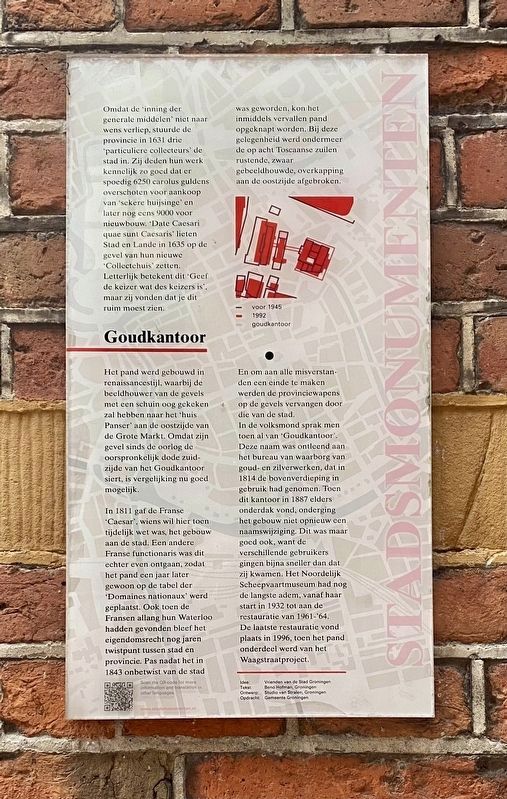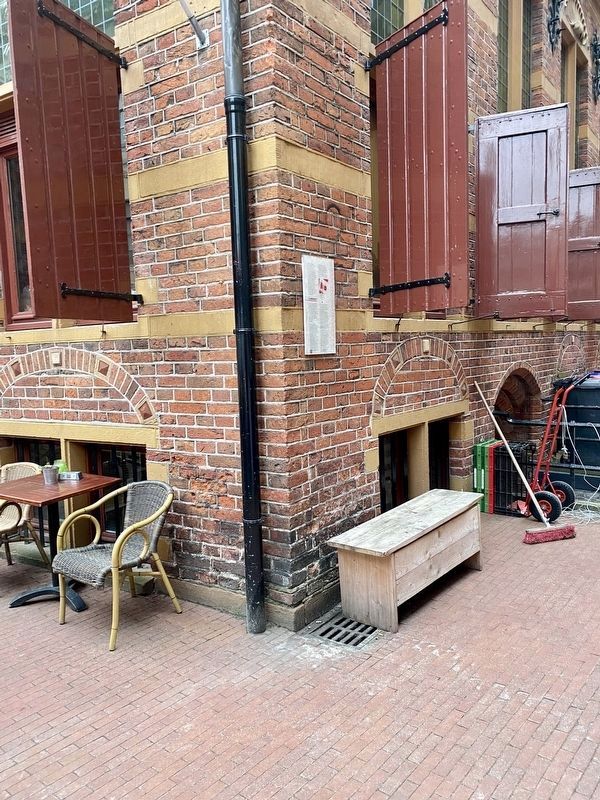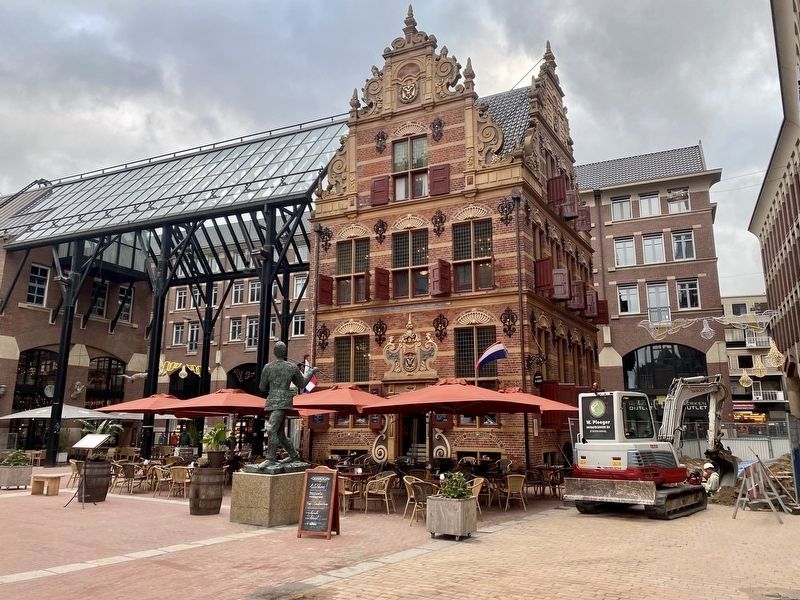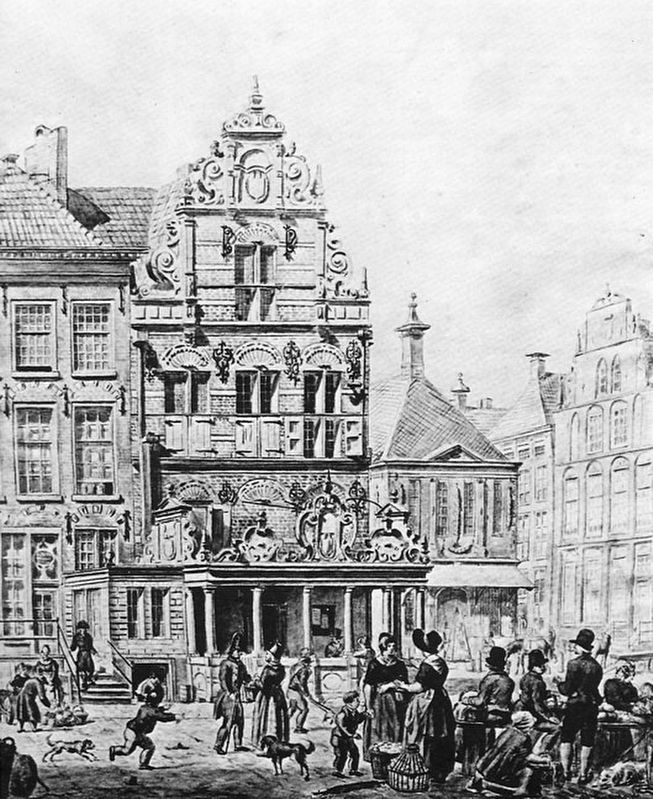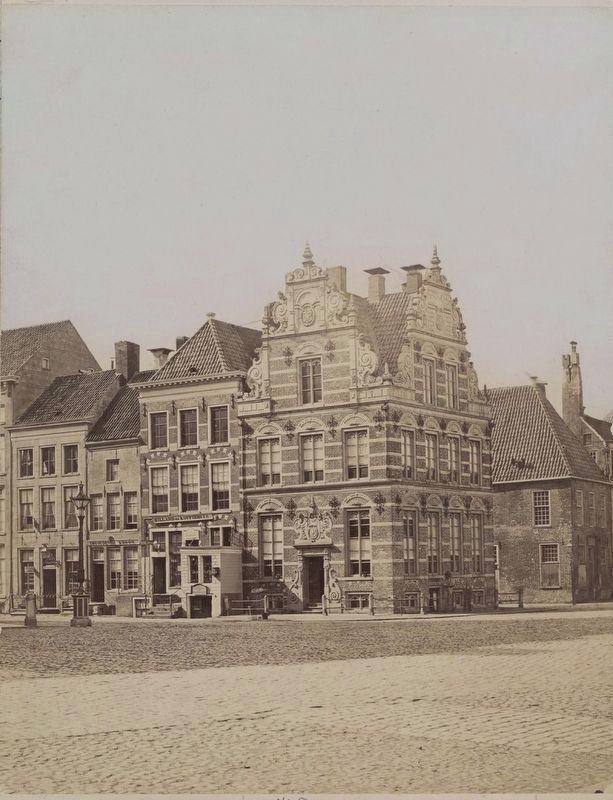Groningen, Netherlands — Northwestern Europe
Goudkantoor
— Stadsmonumenten —
In 1811 gaf de Franse ‘Caesar’, wiens wil hier toen tijdelijk wet was, het gebouw aan de stad. Een andere Franse functionaris was dit echter even ontgaan, zodat het pand een jaar later gewoon op de tabel der ‘Domaines nationaux’ werd geplaatst. Ook toen de Fransen allang hun Waterloo hadden gevonden bleef het eigendomsrecht nog jaren twistpunt tussen stad en provincie. Pas nadat het in 1843 onbetwist van de stad was geworden, kon het inmiddels vervallen pand opgeknapt worden. Bij deze gelegenheid werd onder meer de op acht Toscaanse zuilen rustende, zwaar gebeeldhouwde, overkapping aan de oostzijde afgebroken. En om aan alle misverstanden een einde te maken werden de provinciewapens op de gevels vervangen door die van de stad.
In de volksmond sprak men toen al van ‘Goudkantoor’. Deze naam was ontleend aan het bureau van waarborg van goud- en zilverwerken, dat in 1814 de bovenverdieping in gebruik had genomen. Toen dit kantoor in 1887 elders onderdak vond, onderging het gebouw niet opnieuw een naamswijziging. Dit was maar goed ook, want de verschillende gebruikers gingen bijna sneller dan dat zij kwamen. Het Noordelijk Scheepvaartmuseum had nog de langste adem, vanaf haar start in 1932 tot aan de restauratie van 1961-’64. De laatste restauratie vond plaats in 1996, toen het pand onderdeel werd van het Waagstraatproject.
(English version, from Stadsmonumenten website)
Because the ‘collection of general resources’ did not go as wished, in 1631 the province sent three ‘private collectors’ to the city. They apparently did their work so well that there were quickly 6250 carolus guilder left for the buy of ‘sekere huijsinge’ and later still 9000 for new buildings. ‘Date Caesari quae sunt Caesaris’ let the City and Land set on the facade of their new ‘Collection house’ in 1635. It means literally ‘give the emperor what is of the emperor’, but they thought you should not take it that literally. The building was built in the Renaissance style, whereby the sculptor of the facades was jealous of the ‘House Panser’ on the east side of the Grote Markt. Because his facade beautified the former dead south side of the ‘Goudkantoor’ since the war, there is now a possible comparison.
In 1811 the French ‘Caesar’, whose will was here temporary the law, gave the building to the city. Another French functionary, however, eluded this so that the property just a year later was placed on the table of ‘Domaines nationaux’. Moreover, when the French had already found their Waterloo, the ownership rights stayed for years as point of difference between city and province. Only after it became undisputed of the city in 1843, the now dilapidated building could be refurbished. On this occasion did the – on eight heavy, sculptured Tuscan pillars resting – roof break down at the east side. And to end all the misunderstandings the province coat of arms on the facades got replaced by the one of the city.
Popularly, it was already called ‘Goudkantoor’ (Gold Office). This name was derived from the agency of guarantee of gold- and silverworks, which in 1814 started to use the upper floor. When this office in 1887 found a facility elsewhere, the building did not experience again a name change. This was better, because different users went almost faster than they came. The North Shipping museum stayed the longest, from its start in 1932 until the renovation of 1961-’64. The last renovation took place in 1996, when the building became part of the Waagstraatproject.
Erected by Gemeente Groningen. (Marker Number 7.)
Topics and series. This historical marker is listed in this topic list: Industry & Commerce. In addition, it is included in the Groningen Stadsmonumenten series list.
Location. 53° 13.114′ N, 6° 33.98′ E. Marker is in Groningen. Marker is on Waagplein, on the left when traveling west. Touch for map. Marker is at or near this postal address: Waagplein 1, Groningen 9712 HT, Netherlands. Touch for directions.
Other nearby markers. At least 8 other markers are within walking distance of this marker. Carl von Rabenhaupt (a few steps from this marker); Groningen Municipal Council Members Memorial (within shouting distance of this marker); Chez Dicque (within shouting distance of this marker); De bevrijding van Groningen / The Liberation of Groningen Memorial (within shouting distance of this marker); De Drie Gezusters / The Three Sisters
(about 120 meters away, measured in a direct line); Het Soephuis / The Soup House (about 150 meters away); Martinitoren / St. Martin Tower (about 150 meters away); Martinikerk / St. Martin Church (about 180 meters away). Touch for a list and map of all markers in Groningen.
Also see . . .
1. Historie (Cafe Restaurant Goudkantoor, in Dutch). The building houses a restaurant, which obligingly supplies a history of the building.
Excerpt (in translation): The Gold Office was built in 1635 and was then called the Collectehuis. It was a tax office for the City and Ommelande. The name Goudkantoor, invented by the Groningen population, dates from the period 1814-1887 and was gradually adopted in official documents. In that period, the building was used as a Guarantee Office for Gold and Silver Works. The gold and silver objects were inspected and marked. At the time, the janitor of the Goudkantoor had his living quarters in the basement. Since then, the building has had many other functions, including a natural history museum, before and after the war as a maritime museum, later as a tourist information office, town house, and information desk for the municipality of Groningen.(Submitted on December 12, 2022.)
2. Goudkantoor (Wikipedia).
Excerpt: The Goudkantoor (English: Gold Office) is a building built in 1635 and located on Waagstraat near the Grote Markt (Main Square) in Groningen, Netherlands. Originally it was built as an office for the receiver of the province of Groningen when it was called Collectehuis.(Submitted on December 12, 2022.)
The text on the building, Date Caesari quae sunt Caesaris (Latin) (English: Render unto Caesar that which is Caesar's) refers to the original function. The coat of arms of the city of Groningen is located on the building.
Credits. This page was last revised on December 31, 2023. It was originally submitted on December 12, 2022, by Andrew Ruppenstein of Lamorinda, California. This page has been viewed 114 times since then and 24 times this year. Photos: 1, 2, 3, 4, 5. submitted on December 12, 2022, by Andrew Ruppenstein of Lamorinda, California.
